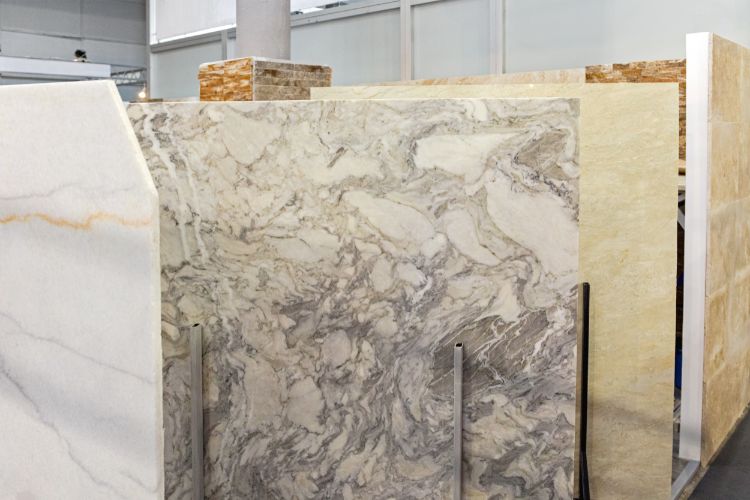
What are the types of stone polishing processes?
Stone polishing is a widely used stone processing technology designed to enhance the gloss and smoothness of stone surfaces. This critical step requires different approaches based on different needs and stone materials, each designed to achieve a specific polish. According to different needs and stone materials, stone polishing can be divided into the following types:
1. Mechanical Polishing
Among these methods, mechanical polishing is one of the most common and effective techniques, which utilizes specialized equipment and grinding heads to refine and beautify the stone surface.
Mechanical polishing involves the use of mechanical equipment such as polishers, grinders, and other precision tools equipped with suitable grinding heads, including diamond polishing pads. These tools are used to treat stone surfaces through a series of grinding, honing, and polishing operations, effectively resolving imperfections, stains, and unevenness, resulting in a smooth, shiny surface. This method is very versatile, and different grinding heads and abrasives can be selected according to the specific requirements of the stone and the desired polishing effect.
One of the main advantages of mechanical polishing is its ability to remove imperfections and enhance the beauty of the stone surface. Whether it is marble, granite, limestone, or other natural stone, mechanical polishing can significantly improve the overall appearance and quality of the stone, making it smooth, bright, and beautiful. By using the appropriate grinding heads and abrasives, this method can customize the polish to meet the unique characteristics and requirements of each stone surface.
Additionally, mechanical polishing plays a vital role in the renovation of older homes by rejuvenating worn or weathered stone surfaces. Over time, stone surfaces can develop blemishes, scratches, and dullness, compromising their natural beauty and elegance. Through mechanical polishing, these defects can be effectively addressed, restoring the luster and vitality of the stone while retaining its historical and architectural significance.
In addition to aesthetics, mechanical polishing also helps improve the functionality of stone surfaces. By creating a smooth, even surface, this method enhances the durability and longevity of the stone, making it more wear-resistant and easier to maintain. This is especially important for older homes, as preserving and enhancing the stone features is vital to maintaining the character and value of the property.
2. Chemical Polishing
Chemical polishing is a specialized method used to treat stone surfaces, especially certain types of stone, such as marble and granite. This polishing technique involves using chemical agents to dissolve tiny particles and stains on the surface of the stone, ultimately achieving a smooth polished finish. Chemical polishing offers a unique way to address the specific characteristics and requirements of different stone materials, making it a valuable tool for the renovation and restoration of older homes.
The principle of chemical polishing is to apply carefully selected chemicals to the stone surface to effectively dissolve blemishes and blemishes to achieve the ideal polishing effect. This method is particularly useful when working with specialty gemstones that may require a more refined and targeted approach to achieve optimal results. By utilizing the appropriate chemical reagents, chemical polishing can be adapted to the unique characteristics and requirements of different stone materials, ensuring that the treatment is tailored to the specific needs of each surface.
One of the main benefits of chemical polishing is its ability to address certain imperfections and stains that are difficult to remove through mechanical or traditional polishing methods. This method utilizes chemicals that effectively target and dissolve stubborn particles and stains, ultimately improving the overall appearance and quality of the stone surface. This makes chemical polishing a valuable tool for solving unique challenges and achieving superior results in older home renovations.
Additionally, chemical polishing offers a degree of customization and adaptability, allowing for the selection of different chemical reagents based on the specific requirements of the stone. This flexibility allows the treatment to be tailored to the characteristics of the stone, ensuring that the chemical polishing process is optimized for the best results. Whether addressing discoloration, stubborn stains, or other surface imperfections, chemical polishing provides a versatile and effective solution for improving the gloss and smoothness of stone surfaces.
3. Fire Polishing:
Fire polishing is a traditional stone polishing method that has been used for centuries, especially for harder stones such as granite and quartzite. The technique involves using high-temperature flames to polish the surface of the stone, resulting in a smooth, shiny surface. Fire polishing is known for its ability to enhance the texture and color of a stone's surface while increasing its hardness and wear resistance. However, due to the use of high-temperature flames, this method requires a high level of expertise and expertise to perform effectively.
The fire polishing process has its roots in applying high-temperature flames to the surface of a stone, thereby changing its texture and appearance. By subjecting the stone to high temperatures, the surface undergoes a refinement process, resulting in a smooth, lustrous surface that enhances its visual appeal and tactile qualities. This method is particularly suitable for harder stones, as they may require a more in-depth approach to achieve the desired polish.
One of the main benefits of fire polishing is its ability to improve the texture and color of the stone surface, creating a visually striking and beautiful result. The high-temperature flame effectively changes the surface of the stone, enhancing its natural characteristics and revealing its inherent beauty. In addition, fire polishing helps increase the hardness and wear resistance of the stone, making it more durable and resistant to daily use and environmental factors.
It is worth noting that fire polishing requires a high degree of skill and experience due to the complexity of using high-temperature flames. Expertise is essential to ensure that the process is carried out safely and efficiently, without causing damage to the stone or compromising its structural integrity. Therefore, fire polishing is usually performed by experienced craftsmen who have the necessary knowledge and proficiency in high-temperature techniques.
4. Water Polishing
Stone polishing is a diverse and important stone processing technique that includes a variety of methods tailored to different stone materials and specific needs. Among these methods, water polishing is a relatively gentle but effective technique that is particularly suitable for processing softer stones such as marble and limestone. This method uses water as a lubricant, combined with abrasives and wet grinding discs, to grind and polish the stone surface to obtain a smooth and shiny surface.
Water polishing offers several unique benefits, making it a valuable tool for stone surface renovation and restoration. By using water as a lubricant, this method effectively reduces heat and friction on the stone surface, minimizing the risk of damage while ensuring a gentle and controlled polishing process. This is especially beneficial for softer stones, as they may be more susceptible to heat-related damage during traditional polishing methods.
In addition to being a gentle method, water polishing can be very effective in removing blemishes and stains from stone surfaces, resulting in a smooth and bright surface. Using abrasives and wet polishing pads allows for precise and controlled polishing, resolving imperfections and enhancing the overall appearance of the stone. This method is ideal for achieving the desired gloss and smoothness of the stone surface, helping to enhance its aesthetics and functionality.
Additionally, water polishing offers a versatile and adaptable stone processing method that can be customized to the specific characteristics and requirements of different stone materials. Whether addressing unique imperfections or achieving a specific polish, water polish can be tailored to meet the varying needs of each stone, ensuring optimal results and maintaining surface integrity.
5. Dry Polishing
Dry polishing is a specialized stone polishing method that offers a water-free alternative and is particularly suitable for working with water-sensitive stones such as petrified wood and plaster. This technology uses dry polishing pads and abrasives to grind and polish the stone surface to achieve a smooth, shiny surface. Dry polishing is aimed at the unique characteristics of stone being sensitive to water, avoiding problems such as water absorption, expansion, deformation, etc., while enhancing the hardness and wear resistance of the stone surface.
This method uses dry polishing pads and abrasives, allowing for precise, controlled polishing that effectively achieves the desired smooth, bright finish on the stone surface. By eliminating the use of water, dry polishing reduces the risk of water absorption and related problems, making it particularly suitable for stones that are sensitive to moisture. This method ensures that the stone surface maintains its integrity and stability, avoiding potential damage from water-related factors.
In addition to its water-free properties, dry polishing also helps improve the hardness and wear resistance of the stone surface. By using dry polishing pads and abrasives, this method enhances the durability and resiliency of the stone, making it more resistant to wear and environmental factors. This is particularly beneficial for water-sensitive stones as it ensures the surface remains intact and maintains its quality over time.
In summary, stone polishing processes mainly include mechanical polishing, chemical polishing, fire polishing, water polishing and dry polishing. Each polishing method has its own applicable stone type and characteristics. According to specific needs and different stone materials, you can choose the appropriate polishing method to achieve the ideal polishing effect.

-
Online service
-
Official wechat
account
-
QQ:40933769
-
E-mail:
zlion@stone-tool.com
Online service
Please feel free to give your inquiry in the form below. We will reply you in 24 hours.

